Objective 7. Locate Supporting Information
As you research and collect information for a new document, you can store all of the piecestext and pictureson the Office Clipboard. Then, you can go to your document and insertpastethe information one piece at a time. This feature is called collect and paste. Word also has commands to help you locate the right word for a sentence and to locate various elements in a document. For example, you can navigate through a document by moving from one section to the next or from one image to the next.
Alert!: If You Are Not Connected to the Internet
It is recommended that you work through these activities on a computer with an Internet connection. You will not be able to complete Activity 4.17 without a connection.
Activity 4.15. Using Collect and Paste to Gather Images
Recall that the Office Clipboard is a temporary storage area maintained by your Windows operating system. When you perform the Copy command or the Cut command, the text that you select is moved onto the Clipboard. From this Clipboard storage area, you can paste text into another location of your document, into another document, or into another Office program. You can copy and then paste a single selection of text without displaying the Clipboard task pane. However, displaying the Clipboard is essential if you want to collect a group of selected text pieces or images and then paste them. The Clipboard can hold up to 24 items, and the Clipboard task pane displays a short representation of each item.
|
1. |
Start Word. From the student files that accompany this textbook, locate and open w04C_Recreation_Ideas. Display the Save As dialog box, and then in your chapter folder, save the file as 4C_Recreation_Ideas_Firstname_Lastname Be sure that nonprinting characters display, and then zoom to Page Width. |
|
|
|
|
2. |
From the Edit menu, click Office Clipboard to display the Clipboard task pane, and then compare your screen with Figure 4.36. Figure 4.36. 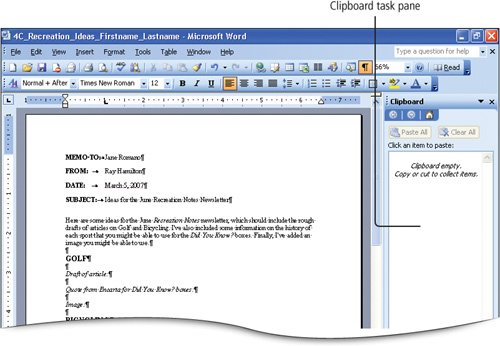
Another Way: To Display the Clipboard Task Pane There are two other ways to display the Clipboard task pane:
|
|
3. |
If the Office Clipboard displays any entries, at the top of the Clipboard task pane, click the Clear All button. From the Insert menu, point to Picture, and then click Clip Art. |
|
4. |
In the Search for box, type golf Click the Search in arrow and select the Everywhere check box. Click the Results should be arrow, select the Clip Art check box, and then clear the other check boxes. Click Go. In the Clip Art task pane, point to the image of a woman golfer. If the image shown in Figure 4.37 is not available, refer to the Note below or choose another golf picture. Figure 4.37. 
NoteInserting Clip Art Images from Your Student Files Both images used for this activity are included with the files for this chapter. To access those files, from the bottom of the Clip Art task pane, click Organize clips. In the Favorites-Microsoft Clip Organizer dialog box, display the File menu, point to Add Clips to Organizer, and then click On My Own. Use the Look in arrow to navigate to the location of your student files and find w04C_Golfer. Select it and then, in the lower right corner of the dialog box, click Add. When the image displays in the dialog box, move the pointer over the arrow on the right side of the image and then click Copy. Repeat the process to use the w04C_Cycling image. Close the dialog box. When prompted, click the Yes button to copy the image to the Office Clipboard. Continue with Activity 4.15. |
|
5. |
Point to the image of the woman golfer, click the arrow, and then click Copy to copy the image to the Clipboard. In the title bar of the Clip Art task pane, click the Other Task Panes arrow |
|
6. |
In the title bar of the Clipboard task pane, click the Other Task Panes arrow Figure 4.38. 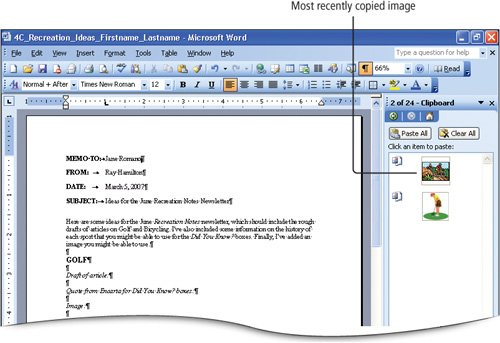
|
|
7. |
On the image of the cyclist, click the arrow and then click Copy to transfer the image to the Clipboard. In the title bar of the Clip Art task pane, click the Other Task Panes arrow. From the task pane menu, click Clipboard. Click Save |
Activity 4.16. Collecting Information from Other Documents
If you need information from another document, you can open the source document, copy the text you need onto the Clipboard, and then paste it into your document later.
|
1. |
Be sure your 4C_Recreation_Ideas document is still displayed on your screen, and the Clipboard task pane displays the two images you have copied. Click the Open button |
|
|
|
|
2. |
In the w04C_Golf_Text file, hold down |
|
3. |
Using the technique you just practiced, copy the text from the w04C_Bicycle_Text file to the Clipboard, and then compare your Clipboard with Figure 4.39. Figure 4.39. 
Notice that as new items are copied to the Office Clipboard, the most recent item displays at the top of the list. |
Activity 4.17. Finding Supporting Information Using the Research Tool
Word includes a research tool with which you can search for information on a variety of topics. You will need an Internet connection to complete this activity.
|
1. |
On the Standard toolbar, click the Research button Figure 4.40. 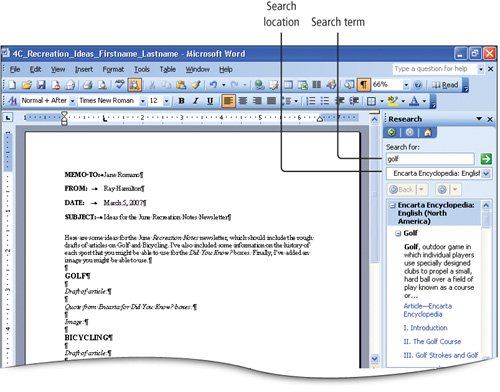
Your screen may indicate only Encyclopedia or it may display the language and version of the active encyclopedia. A list of golf topics displays. |
|
2. |
In the Research task pane list of topics, scroll down if necessary, and then click History. Alert!: If Nothing Displays in the Encarta Window If nothing displays in the Encarta window, on the left side of the screen scroll down if necessary and click History again. |
|
3. |
Scroll down as necessary and move the pointer to the left of the top paragraph that begins Some historians believe, and then drag to the end of the second sentence, which ends the 14th or 15th century, to select the two sentences. Compare your screen with Figure 4.41. Figure 4.41. 
Be sure you have only the two sentences selected. Because the information on Web sites changes often, the information on your screen may differ slightly. More Knowledge: Being Careful of Copyright Issues Nearly everything you find on the Web is protected by copyright law, which protects authors of original works, including text, art, photographs, and music. If you want to use text or graphics that you find online, you will need to get permission. One of the exceptions to this law is the use of small amounts of information for educational purposes, which falls under Fair Use guidelines. Copyright laws in the United States are open to different interpretations, and copyright laws can be very different in other countries. As a general rule, if you want to use someone else's material, always get permission first. |
|
4. |
From the Edit menu, click Copy to add the text to the clipboard. Alternatively, right-click the selected text and from the shortcut menu click Copy. Close |
|
5. |
In the title bar of the Research task pane, click the Other Task Panes arrow |
|
|
|
|
6. |
Click the Other Task Panes arrow Figure 4.42. 
You should have six items in your Clipboard task pane. |
Activity 4.18. Pasting Information from the Clipboard Task Pane
After you have collected text and images from other documents or sources, such as the Internet, you can paste them into your document.
|
1. |
With your 4C_Recreation_Ideas file displayed, locate the text Golf, and then directly below it, click in the blank line under Draft of article. On the Clipboard task pane, under Click an item to paste, click the fourth item in the item list, the one that begins The Desert Park Fine Arts. Compare your screen to Figure 4.43. Figure 4.43. 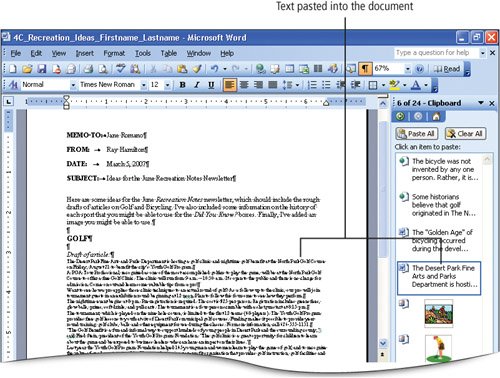
The text is pasted into the document at the insertion point location. |
|
2. |
Below the text you just pasted, click in the blank line under Quote from Encarta for Did You Know? boxes. From the Click an item to paste list on the Clipboard task pane, click the second item in the list, the one that begins Some historians believe. |
|
3. |
Click to position the insertion point in the blank line under Image. From the Click an item to paste list on the Clipboard task pane, click the sixth item in the item list, the graphic of the golfer. Select the graphic, point to the lower right sizing handle, and drag upward to shrink the image so that it moves to the bottom of the first page and the word Bicycling is at the top of Page 2. Compare your screen with Figure 4.44. Figure 4.44. 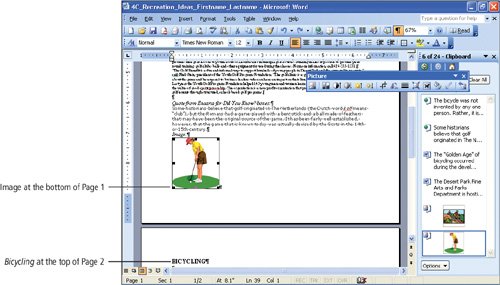
|
|
4. |
Display Page 2 of the document. In the BICYCLING section, click in the blank line under the text Draft of article. On the Clipboard task pane, click the third item, which begins The "Golden Age" of bicycling. |
|
5. |
Click in the blank line under Quote from Encarta for Did You Know? boxes and paste the text that begins The bicycle was not invented. If extra space appears to be inserted above the inserted text, use the Format Painter button to copy the format from the Encarta text on Page 1 to this inserted text. Adjust any other spacing as necessary. Compare your screen with Figure 4.45. Figure 4.45. 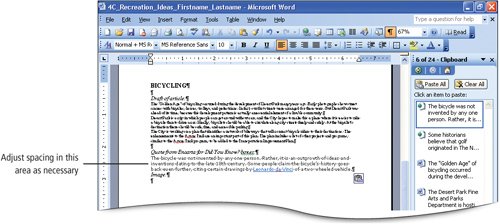
|
|
6. |
Click in the blank line under Image and paste the graphic of the bicyclists. Then, on the Clipboard task pane, point to the first item in the list, click the displayed arrow, and then from the menu, click Delete. |
|
7. |
At the top of the Clipboard task pane, click Clear All to remove the remaining items from the Clipboard. In the title bar of the Clipboard task pane, click the Close button |
Activity 4.19. Using the Thesaurus
The thesaurus is a language tool that assists in your writing by suggesting synonymswords that have the same meaningfor words that you select.
|
1. |
From the Edit menu, click Find. In the Find and Replace dialog box, in the Find what box, type training and click Find Next. |
|
|
|
|
2. |
In the Find and Replace dialog box, click Cancel. Right-click the selected word. From the shortcut menu, point to Synonyms to display a list of synonyms, as shown in Figure 4.46. Figure 4.46. 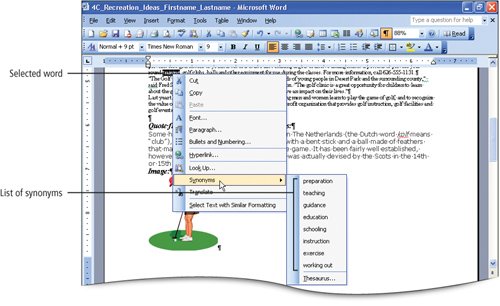
|
|
3. |
In the list of synonyms, click instruction. |
|
4. |
From the Edit menu, click Find. In the Find and Replace dialog box, in the Find what box, type impact and click Find Next. In the Find and Replace dialog box, click Cancel to close the dialog box. Right-click the selected word. From the shortcut menu, point to Synonyms. |
|
|
|
|
5. |
At the bottom of the synonym list, click Thesaurus. Compare your screen with Figure 4.47. Figure 4.47. 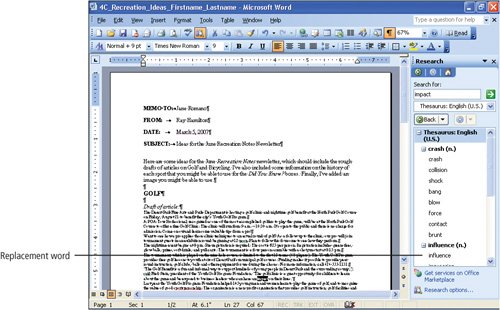
The Research task pane displays and lists words from the English Thesaurus. Notice that there are more options available. |
|
6. |
In the Research task pane, point to influence, click the down arrow on the right side of the word, and then, from the displayed list, click Insert. |
|
7. |
In the title bar of the Research task pane, click the Close button |
|
[Page 539 (continued)] Objective 8 Find Objects with the Select Browse Object Button |
Windows XP
- Chapter One. Getting Started with Windows XP
- Project 1A. Windows XP
- Objective 1. Get Started with Windows XP
- Objective 2. Resize, Move, and Scroll Windows
- Objective 3. Maximize, Restore, Minimize, and Close a Window
- Objective 4. Create a New Folder
- Objective 5. Copy, Move, Rename, and Delete Files
- Objective 6. Find Files and Folders
- Objective 7. Compress Files
- Summary
- Key Terms
- Concepts Assessments
Outlook 2003
- Chapter One. Getting Started with Outlook 2003
- Getting Started with Microsoft Office Outlook 2003
- Project 1A. Exploring Outlook 2003
- Objective 1. Start and Navigate Outlook
- Objective 2. Read and Respond to E-mail
- Objective 3. Store Contact and Task Information
- Objective 4. Work with the Calendar
- Objective 5. Delete Outlook Information and Close Outlook
- Summary
- Key Terms
- Concepts Assessments
- Skill Assessments
- Performance Assessments
- Mastery Assessments
- Problem Solving
- GO! with Help
Internet Explorer
- Chapter One. Getting Started with Internet Explorer
- Getting Started with Internet Explorer 6.0
- Project 1A. College and Career Information
- Objective 1. Start Internet Explorer and Identify Screen Elements
- Objective 2. Navigate the Internet
- Objective 3. Create and Manage Favorites
- Objective 4. Search the Internet
- Objective 5. Save and Print Web Pages
- Summary
- Key Terms
- Concepts Assessments
- Skill Assessments
- Performance Assessments
- Mastery Assessments
- Problem Solving
Computer Concepts
- Chapter One. Basic Computer Concepts
- Objective 1. Define Computer and Identify the Four Basic Computing Functions
- Objective 2. Identify the Different Types of Computers
- Objective 3. Describe Hardware Devices and Their Uses
- Objective 4. Identify Types of Software and Their Uses
- Objective 5. Describe Networks and Define Network Terms
- Objective 6. Identify Safe Computing Practices
- Summary
- In this Chapter You Learned How to
- Key Terms
- Concepts Assessments
Word 2003
Chapter One. Creating Documents with Microsoft Word 2003
- Chapter One. Creating Documents with Microsoft Word 2003
- Getting Started with Microsoft Office Word 2003
- Project 1A. Thank You Letter
- Objective 1. Create and Save a New Document
- Objective 2. Edit Text
- Objective 3. Select, Delete, and Format Text
- Objective 4. Create Footers and Print Documents
- Project 1B. Party Themes
- Objective 5. Navigate the Word Window
- Objective 6. Add a Graphic to a Document
- Objective 7. Use the Spelling and Grammar Checker
- Objective 8. Preview and Print Documents, Close a Document, and Close Word
- Objective 9. Use the Microsoft Help System
- Summary
- Key Terms
- Concepts Assessments
- Skill Assessments
- Performance Assessments
- Mastery Assessments
- Problem Solving
- You and GO!
- Business Running Case
- GO! with Help
Chapter Two. Formatting and Organizing Text
- Formatting and Organizing Text
- Project 2A. Alaska Trip
- Objective 1. Change Document and Paragraph Layout
- Objective 2. Change and Reorganize Text
- Objective 3. Create and Modify Lists
- Project 2B. Research Paper
- Objective 4. Insert and Format Headers and Footers
- Objective 5. Insert Frequently Used Text
- Objective 6. Insert and Format References
- Summary
- Key Terms
- Concepts Assessments
- Skill Assessments
- Performance Assessments
- Mastery Assessments
- Problem Solving
- You and GO!
- Business Running Case
- GO! with Help
Chapter Three. Using Graphics and Tables
- Using Graphics and Tables
- Project 3A. Job Opportunities
- Objective 1. Insert and Modify Clip Art and Pictures
- Objective 2. Use the Drawing Toolbar
- Project 3B. Park Changes
- Objective 3. Set Tab Stops
- Objective 4. Create a Table
- Objective 5. Format a Table
- Objective 6. Create a Table from Existing Text
- Summary
- Key Terms
- Concepts Assessments
- Skill Assessments
- Performance Assessments
- Mastery Assessments
- Problem Solving
- You and GO!
- Business Running Case
- GO! with Help
Chapter Four. Using Special Document Formats, Columns, and Mail Merge
- Using Special Document Formats, Columns, and Mail Merge
- Project 4A. Garden Newsletter
- Objective 1. Create a Decorative Title
- Objective 2. Create Multicolumn Documents
- Objective 3. Add Special Paragraph Formatting
- Objective 4. Use Special Character Formats
- Project 4B. Water Matters
- Objective 5. Insert Hyperlinks
- Objective 6. Preview and Save a Document as a Web Page
- Project 4C. Recreation Ideas
- Objective 7. Locate Supporting Information
- Objective 8. Find Objects with the Select Browse Object Button
- Project 4D. Mailing Labels
- Objective 9. Create Labels Using the Mail Merge Wizard
- Summary
- Key Terms
- Concepts Assessments
- Skill Assessments
- Performance Assessments
- Mastery Assessments
- Problem Solving
- You and GO!
- Business Running Case
- GO! with Help
Excel 2003
Chapter One. Creating a Worksheet and Charting Data
- Creating a Worksheet and Charting Data
- Project 1A. Tableware
- Objective 1. Start Excel and Navigate a Workbook
- Objective 2. Select Parts of a Worksheet
- Objective 3. Enter and Edit Data in a Worksheet
- Objective 4. Construct a Formula and Use the Sum Function
- Objective 5. Format Data and Cells
- Objective 6. Chart Data
- Objective 7. Annotate a Chart
- Objective 8. Prepare a Worksheet for Printing
- Objective 9. Use the Excel Help System
- Project 1B. Gas Usage
- Objective 10. Open and Save an Existing Workbook
- Objective 11. Navigate and Rename Worksheets
- Objective 12. Enter Dates and Clear Formats
- Objective 13. Use a Summary Sheet
- Objective 14. Format Worksheets in a Workbook
- Summary
- Key Terms
- Concepts Assessments
- Skill Assessments
- Performance Assessments
- Mastery Assessments
- Problem Solving
- You and GO!
- Business Running Case
- GO! with Help
Chapter Two. Designing Effective Worksheets
- Designing Effective Worksheets
- Project 2A. Staff Schedule
- Objective 1. Use AutoFill to Fill a Pattern of Column and Row Titles
- Objective 2. Copy Text Using the Fill Handle
- Objective 3. Use AutoFormat
- Objective 4. View, Scroll, and Print Large Worksheets
- Project 2B. Inventory Value
- Objective 5. Design a Worksheet
- Objective 6. Copy Formulas
- Objective 7. Format Percents, Move Formulas, and Wrap Text
- Objective 8. Make Comparisons Using a Pie Chart
- Objective 9. Print a Chart on a Separate Worksheet
- Project 2C. Population Growth
- Objective 10. Design a Worksheet for What-If Analysis
- Objective 11. Perform What-If Analysis
- Objective 12. Compare Data with a Line Chart
- Summary
- Key Terms
- Concepts Assessments
- Skill Assessments
- Performance Assessments
- Mastery Assessments
- Problem Solving
- You and GO!
- Business Running Case
- GO! with Help
Chapter Three. Using Functions and Data Tables
- Using Functions and Data Tables
- Project 3A. Geography Lecture
- Objective 1. Use SUM, AVERAGE, MIN, and MAX Functions
- Objective 2. Use a Chart to Make Comparisons
- Project 3B. Lab Supervisors
- Objective 3. Use COUNTIF and IF Functions, and Apply Conditional Formatting
- Objective 4. Use a Date Function
- Project 3C. Loan Payment
- Objective 5. Use Financial Functions
- Objective 6. Use Goal Seek
- Objective 7. Create a Data Table
- Summary
- Key Terms
- Concepts Assessments
- Skill Assessments
- Performance Assessments
- Mastery Assessments
- Problem Solving
- You and GO!
- Business Running Case
- GO! with Help
Access 2003
Chapter One. Getting Started with Access Databases and Tables
- Getting Started with Access Databases and Tables
- Project 1A. Academic Departments
- Objective 1. Rename a Database
- Objective 2. Start Access, Open an Existing Database, and View Database Objects
- Project 1B. Fundraising
- Objective 3. Create a New Database
- Objective 4. Create a New Table
- Objective 5. Add Records to a Table
- Objective 6. Modify the Table Design
- Objective 7. Create Table Relationships
- Objective 8. Find and Edit Records in a Table
- Objective 9. Print a Table
- Objective 10. Close and Save a Database
- Objective 11. Use the Access Help System
- Summary
- Key Terms
- Concepts Assessments
- Skill Assessments
- Performance Assessments
- Mastery Assessments
- Problem Solving Assessments
- Problem Solving
- You and GO!
- Business Running Case
- GO! with Help
Chapter Two. Sort, Filter, and Query a Database
- Sort, Filter, and Query a Database
- Project 2A. Club Fundraiser
- Objective 1. Sort Records
- Objective 2. Filter Records
- Objective 3. Create a Select Query
- Objective 4. Open and Edit an Existing Query
- Objective 5. Sort Data in a Query
- Objective 6. Specify Text Criteria in a Query
- Objective 7. Print a Query
- Objective 8. Specify Numeric Criteria in a Query
- Objective 9. Use Compound Criteria
- Objective 10. Create a Query Based on More Than One Table
- Objective 11. Use Wildcards in a Query
- Objective 12. Use Calculated Fields in a Query
- Objective 13. Group Data and Calculate Statistics in a Query
- Summary
- Key Terms
- Concepts Assessments
- Skill Assessments
- Performance Assessments
- Mastery Assessments
- Problem Solving
- You and GO!
- Business Running Case
- GO! with Access Help
Chapter Three. Forms and Reports
- Forms and Reports
- Project 3A. Fundraiser
- Objective 1. Create an AutoForm
- Objective 2. Use a Form to Add and Delete Records
- Objective 3. Create a Form Using the Form Wizard
- Objective 4. Modify a Form
- Objective 5. Create an AutoReport
- Objective 6. Create a Report Using the Report Wizard
- Objective 7. Modify the Design of a Report
- Objective 8. Print a Report and Keep Data Together
- Summary
- Key Terms
- Concepts Assessments
- Skill Assessments
- Performance Assessments
- Mastery Assessments
- Problem Solving
- You and GO!
- Business Running Case
- GO! with Help
Powerpoint 2003
Chapter One. Getting Started with PowerPoint 2003
- Getting Started with PowerPoint 2003
- Project 1A. Expansion
- Objective 1. Start and Exit PowerPoint
- Objective 2. Edit a Presentation Using the Outline/Slides Pane
- Objective 3. Format and Edit a Presentation Using the Slide Pane
- Objective 4. View and Edit a Presentation in Slide Sorter View
- Objective 5. View a Slide Show
- Objective 6. Create Headers and Footers
- Objective 7. Print a Presentation
- Objective 8. Use PowerPoint Help
- Summary
- Key Terms
- Concepts Assessments
- Skill Assessments
- Performance Assessments
- Mastery Assessments
- Problem Solving
- You and GO!
- Business Running Case
- GO! with Help
Chapter Two. Creating a Presentation
- Creating a Presentation
- Project 2A. Teenagers
- Objective 1. Create a Presentation
- Objective 2. Modify Slides
- Project 2B. History
- Objective 3. Create a Presentation Using a Design Template
- Objective 4. Import Text from Word
- Objective 5. Move and Copy Text
- Summary
- Key Terms
- Concepts Assessments
- Skill Assessments
- Performance Assessments
- Mastery Assessments
- Problem Solving
- You and GO!
- Business Running Case
- GO! with Help
Chapter Three. Formatting a Presentation
- Project 3A. Emergency
- Objective 1. Format Slide Text
- Objective 2. Modify Placeholders
- Objective 3. Modify Slide Master Elements
- Objective 4. Insert Clip Art
- Project 3B. Volunteers
- Objective 5. Apply Bullets and Numbering
- Objective 6. Customize a Color Scheme
- Objective 7. Modify the Slide Background
- Objective 8. Apply an Animation Scheme
- Summary
- Key Terms
- Concepts Assessments
- Skill Assessments
- Performance Assessments
- Mastery Assessments
- Problem Solving
- You and GO!
- Business Running Case
- GO! with Help
Integrated Projects
Chapter One. Using Access Data with Other Office Applications
- Chapter One. Using Access Data with Other Office Applications
- Introduction
- Project 1A. Meeting Slides
- Objective 1. Export Access Data to Excel
- Objective 2. Create a Formula in Excel
- Objective 3. Create a Chart in Excel
- Objective 4. Copy Access Data into a Word Document
- Objective 5. Copy Excel Data into a Word Document
- Objective 6. Insert an Excel Chart into a PowerPoint Presentation
Chapter Two. Using Tables in Word and Excel
- Chapter Two. Using Tables in Word and Excel
- Introduction
- Project 2A. Meeting Notes
- Objective 1. Plan a Table in Word
- Objective 2. Enter Data and Format a Table in Word
- Objective 3. Create a Table in Word from Excel Data
- Objective 4. Create Excel Worksheet Data from a Word Table
Chapter Three. Using Excel as a Data Source in a Mail Merge
- Chapter Three. Using Excel as a Data Source in a Mail Merge
- Introduction
- Project 3A. Mailing Labels
- Objective 1. Prepare a Mail Merge Document as Mailing Labels
- Objective 2. Choose an Excel Worksheet as a Data Source
- Objective 3. Produce and Save Merged Mailing Labels
- Objective 4. Open a Saved Main Document for Mail Merge
Chapter Four. Linking Data in Office Documents
- Chapter Four. Linking Data in Office Documents
- Introduction
- Project 4A. Weekly Sales
- Objective 1. Insert and Link in Word an Excel Object
- Objective 2. Format an Object in Word
- Objective 3. Open a Word Document That Includes a Linked Object, and Update Links
Chapter Five. Creating Presentation Content from Office Documents
EAN: 2147483647
Pages: 448
 , and then quickly press
, and then quickly press  two times.
two times. . From the task pane menu, click Clipboard.
. From the task pane menu, click Clipboard. and then compare your screen with Figure 4.38.
and then compare your screen with Figure 4.38. , and then from your student files, locate and open the file w04C_Golf_Text.
, and then from your student files, locate and open the file w04C_Golf_Text. to select all the text. On the Standard toolbar, click the Copy button
to select all the text. On the Standard toolbar, click the Copy button  to copy the text to the Clipboard. In the upper right corner of your screen, to the right of the Type a question for help box, click the Close Window button
to copy the text to the Clipboard. In the upper right corner of your screen, to the right of the Type a question for help box, click the Close Window button  to close the file.
to close the file. to display the Research task pane. In the Search for box, type golf Under the Search for box, in the second box, click the arrow, and then click Encarta Encyclopedia. Compare your screen with Figure 4.40.
to display the Research task pane. In the Search for box, type golf Under the Search for box, in the second box, click the arrow, and then click Encarta Encyclopedia. Compare your screen with Figure 4.40. the Internet Explorer window.
the Internet Explorer window.